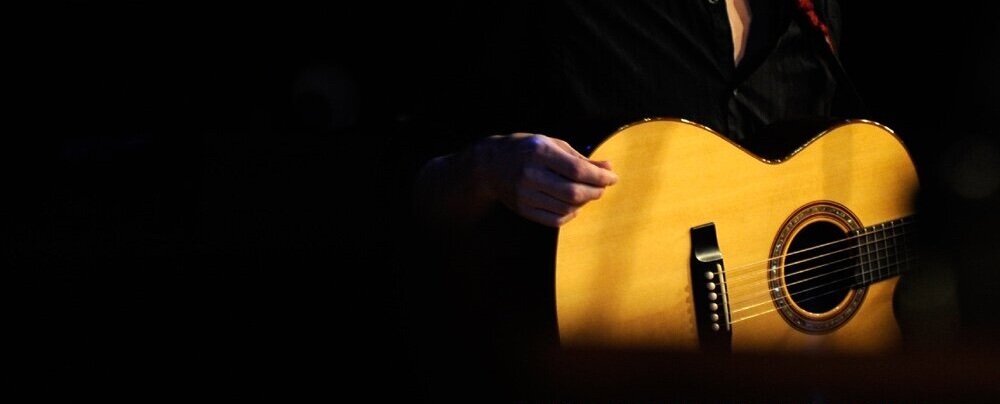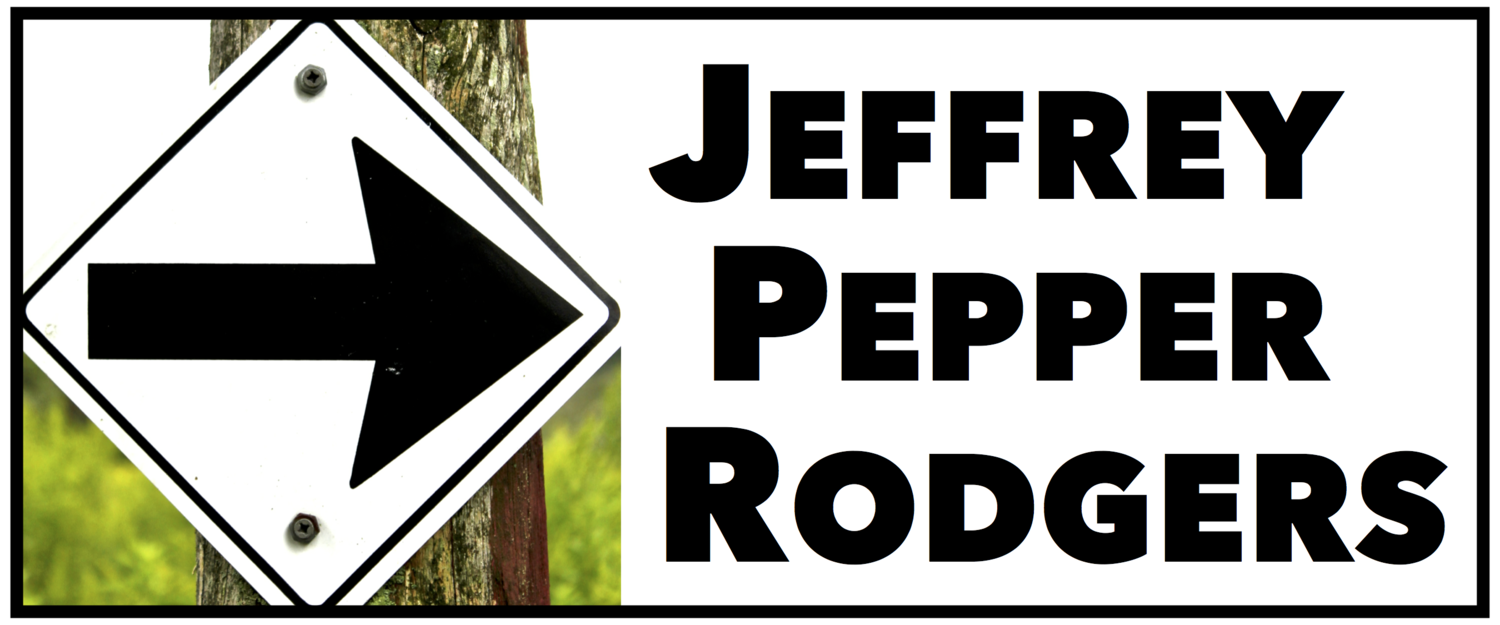
Dead to the Core EP
“Jeffrey Pepper Rodgers sure can play the music—listen to his 'Stella Blue’ and you'll know what I mean. Better still, he can teach it.”
—Dennis McNally, author, A Long Strange Trip: The Inside History of the Grateful Dead
Solo acoustic arrangements of Grateful Dead classics
Featured on The Grateful Dead Hour with David Gans
Learn to play these songs, and more, in this video series
About the album
I've been playing the songs of the Grateful Dead almost as long as I've been playing the guitar.
As a teenager I wore out LPs of Workingman’s Dead and Reckoning in particular and copped many songs for an acoustic duo with my brother and for my high school band. In the ’80s, I caught the Dead when I could during their swings through the Northeast, marveling at how the band was like a car with six guys’ hands on the wheel—anyone could steer in a new direction at any time. Their structured-chaos approach to group improvisation inspired many happy nights with friends trying out our own space jams, exploring sounds with no set roles and no plan for what key to play in or chords to use. Just start playing, listen closely, and go where the music wants to go: that is as close to an M.O. for songwriting (or life) as anything I’ve encountered.
As it happened, my love of writing and music merged into a career as a music journalist and editor of Acoustic Guitar magazine…which led eventually to an opportunity in 1993 to interview Jerry Garcia along with David Grisman—another musical hero of mine. In this final chapter of Garcia’s life, these old pals were having a blast revisiting folk and jug-band tunes and more in Grisman’s northern California home studio. During the photo shoot (where Jay Blakesberg took the portrait of Garcia that later wound up on the cover of Blair Jackson’s biography Garcia: An American Life), Grisman and Garcia jammed on “Jack-A-Roe” on mandolin and a vintage archtop guitar. I will forever feel privileged to have been in the room that day.
Fast-forward another 15 years, and I had another golden opportunity: to spend an afternoon with Bob Weir, in a hotel room in Pennsylvania during a tour with his band RatDog. Cradling an Alvarez-Yairi guitar originally built for Garcia, Weir generously shed light on the idiosyncratic approach to the guitar that has thrilled and mystified players like me for decades. He picked apart “Cassidy,” “The Music Never Stopped,” and other songs and sent me back to the woodshed with many new ideas to ponder.
These recent experiences have brought me full circle, revisiting music of the Grateful Dead after years of focusing on my own songs. I began to experiment with new solo acoustic arrangements inspired by the band’s collective sound, stretching on guitar to play both accompaniment and lead while maintaining a strong groove. Excited by the results, I started mingling these songs with my own in live shows, and the positive response from audiences led eventually to recording Dead to the Core—and also taping the companion video series Learn Seven Grateful Dead Classics for Acoustic Guitar (Homespun).
The songs on Dead to the Core are not only stripped back to one guitar but are all recorded live in the studio. It’s just me singing and playing, with my friend Hanna Richardson singing harmony on two songs. No overdubs. No tricks. Just great songs from a great band… I hope they bring you as much pleasure as they bring me.
—Jeffrey Pepper Rodgers
About the songs
New Speedway Boogie
Music by Jerry Garcia, words by Robert Hunter
The Dead debuted “New Speedway Boogie” right after the violence-marred Altamont Festival of 1969, and Hunter’s lyrics respond to the criticisms heaped on the band and other organizers. I was in kindergarten at that time and didn’t know this backstory until decades later, but I always dug the song’s bluesy groove. “New Speedway Boogie” was never in my repertoire, though, until I happened to try it circa 2004 in dropped-D tuning, and the song just lifted off—rhythm and lead and all. Now “Boogie” is one of my favorite songs to perform solo, and in fact sparked the whole Dead to the Core project. So this arrangement fittingly kicks off the proceedings here.
Tuning: D A D G B E
Brokedown Palace
Music by Jerry Garcia, words by Robert Hunter
I always loved this song, with its churchy harmonies and soothing imagery, and first performed it in high school as a duet. But this guitar arrangement is entirely new. I play “Brokedown Palace” a good bit faster than the original recording on American Beauty (1970), adding some guitar figures around the melody and between verses. Jazz vocalist Hanna Richardson joined me for the duet vocal, with no rehearsal—so what you hear is one of our very first run-throughs of the song.
Tuning: D A D G B E, capo 3
Fire on the Mountain
Music by Mickey Hart, words by Robert Hunter
As a song that’s instrumentally all about the drums and bass, “Fire on the Mountain” might seem an unlikely candidate for a guitar arrangement. But as a guitarist I see myself as half drummer anyway, so I loved the challenge of making this one groove. I had heard many great live performances of “Fire on the Mountain” and also knew the cool instrumental version (“Happiness Is Drumming”) on Mickey Hart’s 1975 album Diga Rhythm Band. But I can trace this arrangement to a specific night just a few years ago, at a shelter along Vermont’s Long Trail, where a fellow backpacker sang this song quietly to herself by the campfire. When I got back to civilization and my guitar, I immediately started playing this song for the first time. I found my own slant in part by shifting from the original key of B all the way down to F#.
Standard tuning
Black Peter
Music by Jerry Garcia, words by Robert Hunter
Of all the songs here, this version is the closest to the original recording, on the stellar acoustic album Workingman’s Dead (1970). I’m in the same key and use similar guitar voicings as the main rhythm part, though to get a complete-sounding arrangement with one guitar I add quite a bit of string percussion and little fills. “Black Peter” is a blues of sorts, but the bridge section (starting with “See here how everything…”) has some truly weird and inspired chord changes. The Dead’s songs have deep roots, but they were never afraid to go out on a limb.
Standard tuning
Cassidy
Music by Bob Weir, words by John Perry Barlow
Bob Weir wrote this song at a communal house where a baby girl named Cassidy was born while he was writing the music. The lyrics, by Weir’s songwriting partner John Perry Barlow, also pay tribute to ’60s counterculture icon Neal Cassady. I used to play “Cassidy” in standard tuning, but when Weir told me that he wrote the song in a now-forgotten open tuning (and recorded it that way on Ace, 1972), I decided to explore that direction. When I tried “Cassidy” in D A D G A D tuning, everything fell into place: not just the chords but many of the lead riffs and guitar melody lines (as heard in the great live acoustic version on Reckoning, 1981). As with “Brokedown Palace,” Hanna Richardson sang the duet vocal live with me in the studio.
Tuning: D A D G A D, capo 2
Stella Blue
Music by Jerry Garcia, words by Robert Hunter
Arguably the most beautiful song in the Dead repertoire, “Stella Blue” was recorded on Wake of the Flood (1973) but like so many of their songs really came to life onstage, inspiring some of Garcia’s most majestic solos. The original version is in the key of E, but I knew right away that I wanted to play “Stella Blue” in dropped-D tuning, to take advantage of the resonant open bass strings. The tuning allows me to shift the chord voicings into unusual spots in the lower register of the guitar, and also to echo some of Garcia’s signature single-note lines while keeping the rhythm and bass going. To set the right mood in the studio, we turned off the lights, and I recorded this track in the glow of a tube light draped over a music stand.
Tuning: D A D G B E

